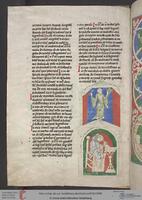Hildegard of Bingen's Scivias
Type:
Illuminated manuscripts
Date:
ca. 1200
Location or Findspot (Modern-Day Country):
Germany
Dimensions:
41.5 × 29 cm
Description:
Hildegard of Bingen (1098–1179) was a Benedictine abbess and author of numerous works, including several visionary texts. One of these, written down in the 1140s, was the Scivias, a contraction of “Know the Ways [of the Lord]” (Latin Scito vias Domini). Several medieval copies of this work survive, and two contain illuminations. The first is called the Rupertsberg manuscript, after the name of the monastery founded by Hildegard in which it was made, perhaps under Hildegard’s own supervision; it can be roughly dated to the last quarter of the twelfth century. This book was destroyed in Weisbaden during the Second World War, but it is known from photographs, and a color copy was drawn by nuns at Eibingen, another convent founded by Hildegard.
The second manuscript, reproduced here, was made around 1200 in the Cistercian monastery of Salem, an institution that had close connections to Hildegard. Unlike the Rupertsberg copy, which contained a total of thirty-five illustrations of Hildegard’s visions, the Salem version only has ten images, and they are visually very different. There is a great deal of controversy about the relationship of the two versions to each other—and to Hildegard herself. Both, however, include representations of the abbess at the beginning of the book. They show her holding a small diptych and a stylus for writing on the wax therein (fol. 8v). This was a preferred method for sketching out ideas or drawings in the Middle Ages.
In the Salem miniature, the task of copying the book itself is left to Hildegard’s male confidant, advisor, and secretary, Volmar (fol. 8v). While Volmar looks down intently as he works with a quill pen and a knife (for erasing any mistakes), Hildegard peers across the page as if she is in the middle of a vision. She gazes at the large historiated initial I that announces the opening of the book. It contains a simplified Tree of Jesse, which shows the genealogy of Jesus through Mary, rooted in Jesse, the father of King David (from whom Mary was thought to descend) (fol. 9r). Such large initial Is were common at the beginning of medieval bibles because the letter is the beginning of In principio, “In the beginning,” the opening of Genesis. Employing this iconography suggests the sacred status of Hildegard’s work. She has long been considered a saint and was formally canonized in 2012.
Relevant Primary Sources
The second manuscript, reproduced here, was made around 1200 in the Cistercian monastery of Salem, an institution that had close connections to Hildegard. Unlike the Rupertsberg copy, which contained a total of thirty-five illustrations of Hildegard’s visions, the Salem version only has ten images, and they are visually very different. There is a great deal of controversy about the relationship of the two versions to each other—and to Hildegard herself. Both, however, include representations of the abbess at the beginning of the book. They show her holding a small diptych and a stylus for writing on the wax therein (fol. 8v). This was a preferred method for sketching out ideas or drawings in the Middle Ages.
In the Salem miniature, the task of copying the book itself is left to Hildegard’s male confidant, advisor, and secretary, Volmar (fol. 8v). While Volmar looks down intently as he works with a quill pen and a knife (for erasing any mistakes), Hildegard peers across the page as if she is in the middle of a vision. She gazes at the large historiated initial I that announces the opening of the book. It contains a simplified Tree of Jesse, which shows the genealogy of Jesus through Mary, rooted in Jesse, the father of King David (from whom Mary was thought to descend) (fol. 9r). Such large initial Is were common at the beginning of medieval bibles because the letter is the beginning of In principio, “In the beginning,” the opening of Genesis. Employing this iconography suggests the sacred status of Hildegard’s work. She has long been considered a saint and was formally canonized in 2012.
Relevant Primary Sources
Relevant Textbook Chapter(s):
7
Repository and Online Resources:
• The complete manuscript has been digitized on the website of the Heidelberg University Library.
Image Credits:
Heidelberg, Universitätsbibliothek, CC BY-SA-4.0


